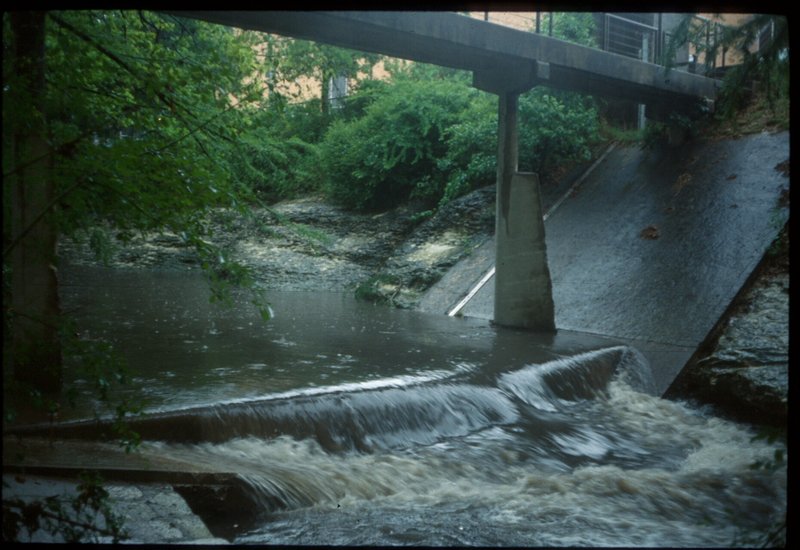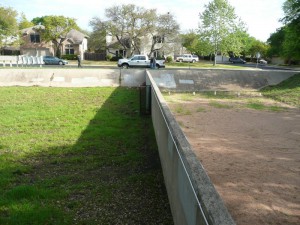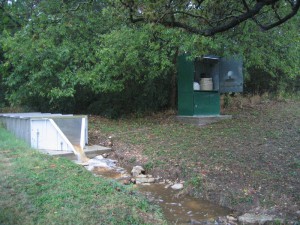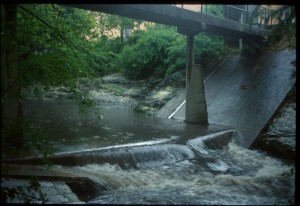
Waller Creek is one of the oldest monitoring sites in the Austin area. First a U.S. Geological Survey site in the 1950s, it is now monitored by the City of Austin through its Texas Pollutant Discharge Elimination System permit. Image credit: COA-WPD-WQM
Stormwater runoff can cause varying and complex issues across a watershed, from stream bank erosion to deteriorating benthic community health. Monitoring can help identify problems and set a baseline for background pollution, while modeling can be used to assess potential solutions, both structural and nonstructural. Once those solutions are put into place, monitoring can help determine if they are working and further refine the models. The City of Austin, for example, is using monitoring as a way to develop and direct watershed regulations with science and to enhance stormwater control design criteria.
“Monitoring is one side of a coin, modeling is the other,” said Roger Glick, supervising engineer with the City of Austin’s Watershed Protection Department. “Monitoring shows you what is, and modeling can show you what will be.”
Before starting a monitoring program, however, communities should first determine their objectives and design their program accordingly. “First assess data gaps, and then try to fill those gaps rather than just collecting data,” Glick said during a presentation at the U.S. Environmental Protection Agency Region 6 Stormwater Conference in July. The conference was co-hosted by the South Central Chapter of the International Erosion Control Association.
Austin Watershed Ordinances
The City of Austin adopted its first watershed ordinance in 1974, a first attempt at directing development patterns to prevent flooding. While initial efforts focused primarily on flooding, the ordinances have evolved to reflect a growing understanding of water quality and hydrology aided by monitoring and modeling.
In 1986, the city passed the Comprehensive Watersheds Ordinance. For the first time, it extended protection beyond those watersheds providing drinking water and included designation of critical environmental features. The city extended protection to urban watersheds in 1991, requiring urban water quality controls for treating stormwater runoff. The ordinance allowed for fee-in-lieu payments in place of water quality control structures and established critical water quality zones with development restrictions in watersheds outside of the central business district.
With improved data, science and experience, 25 years after the comprehensive ordinance, the city council passed the Watershed Protection Ordinance in October 2013. The new ordinance expands its focus from western to eastern watersheds, extending stream buffer requirements to an additional 644 km (400 mi) of headwater streams. The area’s eastern watersheds have a long history of farming, broader floodplains, and more erosive clay soils. The buffer requirements will halt development in close proximity to headwater stream banks, reducing erosion hazards and related public expenditures.
The new ordinance also aligns with the city’s Imagine Austin Comprehensive Plan. The plan seeks to increase the density of urban development within the Desired Development Zone while expanding protection of environmentally sensitive areas and focusing on both preservation and restoration throughout the region. Imagine Austin’s goal is to mimic natural hydrology by integrating green infrastructure into the city and providing greater access and connectivity to greenways and trails.
Stormwater Controls
Both the Comprehensive Watersheds Ordinance and the newly adopted Watershed Protection Ordinance require detention and sedimentation-filtration practices. Controls must be able to capture at least half an inch (13 mm) of runoff and be equivalent to the Austin sand filter in both volume control and pollutant removal, as laid out in the city’s Environmental Criteria Manual.
The City of Austin was a forerunner in developing the sand filter design in the 1980s. The practice uses a combination of sedimentation, filtration, and absorption. However, it requires a significant amount of space, generally 2% to 7% of the drainage area, according to the Federal Highway Administration.
Monitoring is helping the city determine which stormwater controls are equivalent to the sand filter and whether their performance can meet Austin’s water quality standards.
Through experience evaluating data from stormwater controls, the City of Austin is moving from percent concentration to effluent probability. “Percent removal does not necessarily show that the practice is functioning as intended,” Glick said. For example, high percent removal can be obtained even if the outflow concentrations are higher than expected if the inflow concentrations are high enough. In contrast, effluent probability examines the expected effluent concentration, independent of the influent concentration.
Monitoring and modeling are also helping the city gauge how nonstructural controls, such as public education, regulations, and programmatic changes, could affect water quality.
Monitoring
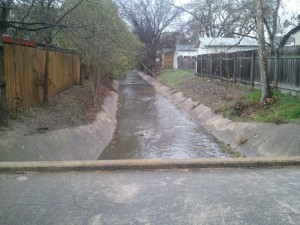
The City of Austin monitors waterways affected by a variety of land uses, including this cement-lined channel in a residential neighborhood. Image credit: COA-WPD-WQM
In 1984, the City of Austin began evaluating post-development water quality conditions across various land uses. In that time, it has monitored 67 sites covering 1414 ha (3493 ac) and has 14 active sites, not counting those for stormwater control evaluation. The city monitors smaller streams, with equipment placed where runoff collects from area between 8 and 81 ha (20 – 200 ac) and enters a storm drain or stream. U.S. Geological Survey (USGS) stream gauge data is used for larger waterways.
The City of Austin monitors flow and quality as well as other indicators of stream health through ambient monitoring, bioassessments, and more. They have found a good correlation between flow volume and velocity and aquatic health, which is useful for the city’s modeling efforts. “We focus first on flow, to make sure there is water in the stream. Without water, there is no aquatic life,” Glick said.
During his presentation, Glick also discussed water quality sampling and questions to ask before getting started. The frequency of sampling and constituents of concern should be determined based on the questions a community is trying to answer. The City of Austin is concerned primarily with bacteria, sediments, and nutrients, which may cause algal blooms and fish kills or affect contact recreation in local waters. Area waterways are home to several endangered species, so the city also monitors for chemical pollutants harmful to aquatic life, including residential pesticides, heavy metals, and polycyclic aromatic hydrocarbons.
The constituents selected for sampling can determine whether it is done manually or automatically. For instance, it is not a good practice to use automatic sampling for bacteria, but staff safety and logistics must be considered for manual sampling, Glick said. “It doesn’t rain only from 8 to 5. How will staff respond to after-hours storms, and where will they take the samples before their holding time expires?”
When sampling, there is also the option to take composite or discrete samples. Composite sampling involves combining samples taken at various times. It is less expensive because it results in fewer overall samples, but “data is lost during a storm,” Glick said. He also warns that if using composite only, one bad sample could skew results. “You can, however, do a mixture of composite and discrete sampling,” he said.
Data management should not be overlooked. This includes how data will be moved from the field to the office as well as data storage and security. “You can get half a million data points per year at just one site,” Glick said. Quality control, ensuring that that the results make sense, and measuring uncertainty also are important. Between errors in stage and flow calculations, rainfall data, sampling, and lab analysis, compounded errors could add up to 100%.
The city’s monitoring efforts have not yet revealed water quality improvements in streams, but “those changes happen over decades, not overnight,” Glick said. “To demonstrate the effects of new codes and regulations over the long-term, we are using modeling. With modeling, we can also see what would have happened if not for regulations.”
Modeling
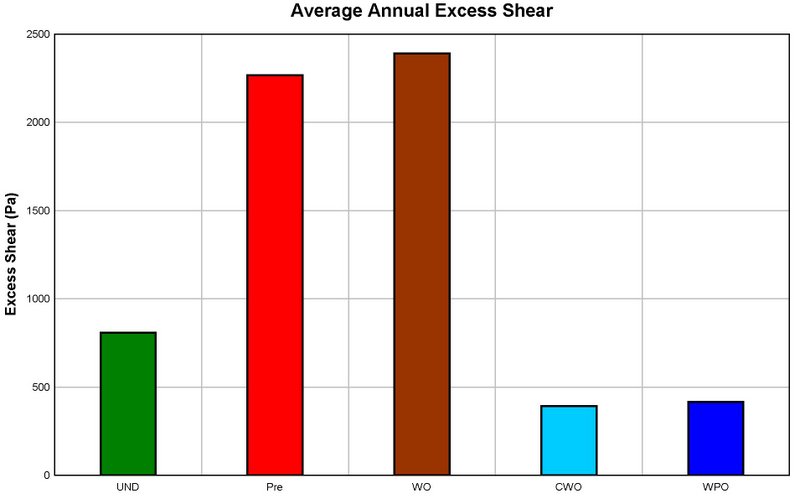
The undeveloped condition (UND), development without controls (PRE), the Watershed Ordinance with detention-only (WO), and the Comprehensive Watershed Ordinance (CWO) and the Watershed Protection Ordinance (WPO) both with detention and sand filter are compared in terms of average annual excess shear. Both the CWO and WPO scenarios are expected to reduce erosion as modeled by the Soil and Water Assessment Tool. Image credit: COA-WPD-WQM
The first question of modeling is what will be measured. The City of Austin is utilizing flow as the primary model output and uses that to assess erosion through excess sheer — the ability of stream flow to move particles. Additionally, the city is looking at aquatic health, primarily as a component of flow.
Based on the factors the city wanted to study, they researched model options and selected the Soil and Water Assessment Tool (SWAT), a model developed by Texas A&M University and the U.S. Department of Agriculture’s research service. The tool has a short time-step that allows users to capture the flashiness of a stream during a storm and can model changes over a long time period. The city uses the tool to model stormwater controls common in Austin as well as the development scenarios directed by the watershed ordinances.
The SWAT model automatically delineates subbasins based on land elevation or topography data, sourced either from a local database or the U.S. Geological Survey’s National Elevation Dataset. Using this elevation data, the tool computes slopes. It overlays soil and subsurface data from the USDA’s State Soil Geographic (STATSGO) Database or the Soil Survey Geographic (SSURGO) Database to create hydrologic response units. The National Oceanic and Atmospheric Administration’s National Climate data Center can provide climate and weather information.
Using the SWAT model, the city simulated various scenarios, including an undeveloped state and one with no regulations, as well as the conditions of all three watershed ordinances. “Through modeling, we have been able to show that newer Austin regulations have been helpful from flooding, erosion, and aquatic life standpoints,” Glick said.
During small storms, detention basins — required under all of the city’s watershed ordinances — do little to protect water quality, but they are needed to protect against flooding during large events. Requiring a combination of detention and water quality controls, the most recent watershed ordinances decreased flooding and erosion potential. However, when detention was used alone, as under the original watershed ordinance, it actually created additional erosion problems.
The City of Austin also found that as development occurs, the number of high-stream flow events increases, but the duration or number of days with low stream flow also increases. Modeling showed that with the Watershed Protection Ordinance, streams would be dry less often. Water quality controls would help reduce the number of high-flow events and decrease average daily changes in flow variability. “With changes to the normal wet-dry cycle, bugs can’t get through their life cycle,” Glick said. “A flashy stream also disturbs habitat.”
…
By monitoring and modeling to answer questions, the City of Austin is guiding the selection and design of stormwater controls and the development of regulations with data-driven decisions. These efforts are in turn helping the city improve aquatic health and better protect against flooding and erosion.
Do you have any monitoring or modeling advice? Share it with us in the comments section below.

